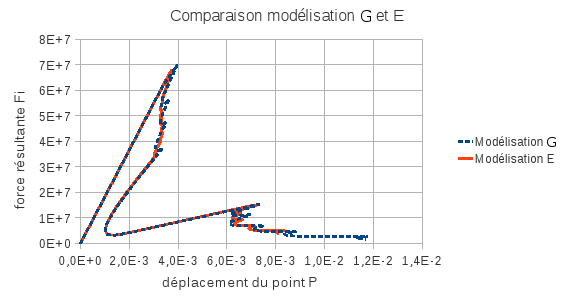8. G modeling#
8.1. Characteristics of G modeling#
The characteristics of the modeling are strictly identical to the modeling \(E\). Only the mesh differs.
8.2. Characteristics of the mesh#
An entirely triangular, unregulated mesh of the plate is produced. Some of the edges are consistent with the crack. Some are intersected.
Volume elements (\(\mathit{DCB}\)): 698 TRI3
8.3. G modeling results#
The result is slightly different from modeling \(D\). This is due to the mesh difference between the two models. The small snap-backs are digital in origin and linked to the refinement of the mesh. Here they are bigger because the mesh is less refined (fig.). So we change the reference values for the same reasons as modeling \(F\).

Figure 8.3-a : comparison between G and E models
Size tested |
Reference type |
Code_Aster |
Tolerance ( \(\text{\%}\) )) ** |
\(U\) at moment 50 |
|
3.21777D-03 |
0.10 |
\(F\) at time 50 |
|
3.6512D+07 |
0.10 |
\(U\) at time 100 |
|
7.41292D-03 |
0.10 |
\(F\) at time 100 |
|
1.54984D+07 |
0.10 |
\(U\) at the moment 150 |
|
7.76637D-03 |
0.10 |
\(F\) at the moment 150 |
|
4.65793D+06 |
0.10 |